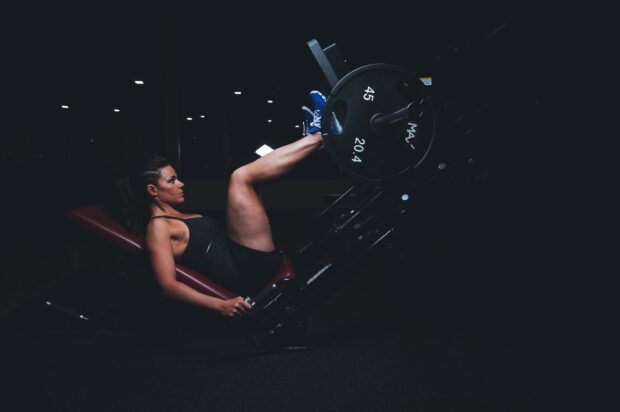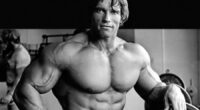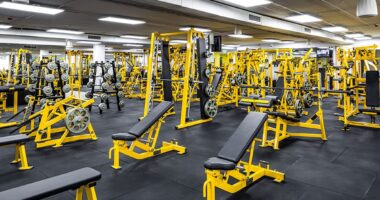I have a simple question: is there something more than a bodybuilding community or industry that is worthwhile for me to invest my time and energy into? I have been a member of this community for a while now, but I’m having some doubts.
Introduction: Hey everyone, I am sure you’ve heard of the push/pull/legs split (or the PPL) by now. Now if you haven’t, I’m going to give you a quick rundown of what it is. The PPL is a training split where you do push / pull / legs in that order, each muscle group working one day per week. Push / Pull / Legs – The push/pull/legs split is a very popular split for building muscle mass. I’ve been using it as a base for my training for the last year or so, and I’ve seen some great results.
Have you ever wondered why leg exercises are never listed as part of a muscle building routine? Is it because they don’t really work? Or is it because leg exercises are boring and not worth your time? If you’ve ever wondered, then you’re in luck. In this article I will show you how to build muscle the right way with push / pull / legs splits.
The push/pull/leg splits is one of the most popular muscle building training splits in the world.
With the split press/pull/legs you train the whole body on three separate training days:
- Press day = chest/shoulder/triceps
- Pull day = back / biceps
- Legs tag = Quadriceps / Hamstrings / Calves
The push/pull/leg split has many advantages over other types of training splits. The main advantage of this classification is the reduction of overlap between muscle groups. That is, you take all the muscles that work in similar exercises and train them on the same day.
The push/pull/leg split is a very effective and efficient way to train for muscle growth because it optimizes your recovery, but still allows you to train each muscle group with more volume and intensity.
There are three types of press/shank/leg splits that bodybuilders use to build muscle:
In this detailed guide, I’ll explain how to use each of these splits to train your push-ups/pull-ups/legs to build maximum muscle mass.
The Six-Day Split Push/Pull/Legs is probably the most effective variation for advanced bodybuilders. This allows you to train each muscle group twice a week, which is a fantastic training frequency for building muscle.
Many of the world’s best bodybuilders, including Ronnie Coleman, Chris Bumstead and Stan Efferding, have used this split to prepare for bodybuilding competitions. The biggest drawback to this split is that you need to have an above average recovery capacity to recover from 6 hard workouts a week.
The Four-Day Split Push/Pull/Legs is another great option for building muscle. This option allows you to train muscle groups every 5-6 days, which is ideal for building size and strength.
Some of the top bodybuilding coaches like Dante Trudel, John Meadows and Dorian Yates sometimes recommend this split.
The three-day split (press/pull/legs) is less popular for muscle building. However, it can be a good choice for very strong bodybuilders and those with below average recovery capabilities. You only train each body part once a week, which means you can use a lot of volume and intensity per workout without overtraining.
I hope you found this overview of the different bench press/pull/leg splits helpful. Let’s take a closer look at how some of the world’s best bodybuilders use these splits to build maximum muscle mass.
Part 1: Six Day Split Presses / Deadlift / Legs
The 6-day split (push/pull/leg) is one of the most well-known training splits in the bodybuilding world. Many legendary bodybuilders, including Ronnie Coleman, have used this split to build maximum muscle.
With a 6-day split (press/pull/legs), you will perform 2 press exercises, 2 pull exercises and 2 leg exercises per week. For example:
Six Day Split Presses / Deadlift / Legs
- Monday: Click on .
- Tuesday: Shoot
- Wednesday: Feet
- Thursday: Click on .
- Friday: Shoot
- Saturday: Feet
- Sunday: On the website
This split works incredibly well for building muscle mass if you can recover. This distribution allows you to train each muscle group twice a week at a relatively high volume and intensity.
Many bodybuilders, such as. B. Ronnie Coleman, prefers to do 2 totally different workouts per week for each muscle group. Ronnie Coleman performed workout A for each muscle group at the beginning of the week and workout B for each muscle group at the end of the week. For example:
Ronnie Coleman Training Split
- Monday: No. 1 Pull out
- Tuesday: Legs 1
- Wednesday: Key 1
- Thursday: Sweater #2
- Friday: Legs #2
- Saturday: Button no. 2
- Sunday: On the website
Ronnie’s two weekly workouts used totally different exercises for each muscle group. This is a great muscle building strategy because it allows you to overload your muscles in two different ways throughout the week. For some people, strengthening can also be helpful, as it makes it harder for the nervous system to adapt to the routine.
Many experienced bodybuilders and powerlifters have found that they can gain strength over a longer period of time by alternating two different workouts for each muscle group.
Ronnie Coleman has organized his chest training in a very interesting way: He performed 3 dumbbell exercises on the first weekly bench press day and 3 dumbbell exercises on the second weekly bench press day. For example:
Ronnie Coleman #1Pectoral and Triceps Training
- A1 : Flat bench press, 3-5 sets of 5-15 reps each
- B1 : Bench press, 3-5 sets with 8-20 reps
- C1 : Bench press, 3-5 sets with 8-20 reps
- D1 : Single leg bench press, 3-5 sets of 8-20 reps.
- E1 : Hammer Dips, 3-5 sets with 8-20 reps
- F1 : Triceps push-up standing on cable, 3-5 sets of 8-20 reps each.
Here is a training video for this session:
Ronnie Coleman Chest/Triceps Training #2
- A1: DB flat abs, 3-5 sets of 5-15 reps each
- B1 : Bench press, 3-5 sets of 5-15 reps each
- C1 : Flat DB Machs, 3-5 sets of 8-20 reps each
- D1 : Bench press (behind the head), 3-5 sets of 8-20 reps each
- D2 : Closed grip bench press (with barbell), 3-5 sets of 8-20 reps each
- E1 : Double Arm Bench Press DB, 3-5 sets of 8-20 reps.
- F1 : Triceps lunges with both hands, 3-5 sets of 8-20 reps.
Here is a training video for this session:
These workouts can be very similar.
In each workout, Ronnie chooses 3 chest exercises and works up to a set of 5-15 reps, which he performs to failure. The big difference is that Ronnie focuses on the dumbbell press exercises on day one and the barbell press exercises on day two.
This change is significant enough to stimulate the breasts in a completely different way and provide progress over a longer period of time.
Classic M. Olympic bodybuilding champion Chris Bumstead takes a similar approach when training with a 6-day press/pull/leg split. Here’s what his weekly training schedule looks like:
Chris Bumstead Leg Press / Chin Up / Split
- Monday: Key 1
- Tuesday: No. 1 Pull out
- Wednesday: Legs 1
- Thursday: Button no. 2
- Friday: Sweater #2
- Saturday: Legs #2
- Sunday: On the website
Chris alternates between two similar, but slightly different workouts for each muscle group. His workouts use similar patterns of sets and reps, but the exercises are completely different. This small change is enough to prevent him from becoming physically or mentally exhausted.
Let’s take a look at some of Chris’s pull-ups. Look at this:
Chris Bumsteads 1. Traction drive
- A1 : Leg raise (any grip), 3 sets of 8-10 reps**.
- B1 : Inclined rows with dumbbell, 3 x 6-8, 6-8, 10-12
- C1 : DB-Curl at 60 degrees, 4 sets of 10-12 reps each
- D1: pull-ups (each grip), 3 sets to failure
- E1 : Standing curls at the bar, 2 sets of 10-12 reps
- F1 : Standing curls at the bar, 2 sets of 40 seconds in tension
** Perform a double fall to failure in the last set.
Chris Bumstead Workout Pull-Up #2
- A1: pull-ups (any variation), 3 easy sets with bodyweight only
- B1: Bar pull-ups, 2 sets of 8-10 reps
- C1 : Hammer Twist, 3 sets of 8-10 reps
- D1: rear grip, 3 sets of 10-12 reps each
- E1: rope twists, 3 sets of 10-12 repetitions
- F1 : Seated cable rows, 2 sets of 20 reps each.
- G1 : Standing Curls DB, 1 set on the rack to failure
Chris Bumstead uses a lot more variety in his workouts than Ronnie Coleman. In fact, Chris’ two formations are not comparable at all! Chris uses different exercises and different sets and repetition patterns between the two workouts. This is a great strategy for building muscle if you respond well to more variety in your workouts.
Stan Efferding is another bodybuilder who used a variation of the 6-day push/pull/leg workout to prepare for bodybuilding competitions.
Stan trained twice a day, 6 days a week to prepare for his bodybuilding performances. He took his usual workout for bench press, deadlifts and legs and split it into a morning and evening workout. Look at this:
Split Stan Efferding in Bodybuilding
- Monday
- Tuesday
- AM: Back
- PM : Biceps / Triceps
- Environment
- Thursday
- Friday
- AM: Back
- PM : Biceps / Triceps
- Saturday
- Sunday
The only difference between this split and the usual 6-day press/pull/leg split is that Stan trained his triceps on the day of the pull.
Then why did Stan train twice a day to compete in bodybuilding? Stan thought it was an easy way to stimulate muscle growth twice a day instead of once. Here are Stan’s exact thoughts on the subject:
I prefer to do my workouts twice a day. 40 minutes in the morning and 30 minutes in the evening. We train the quads for 40 minutes, then come back in the evening and do 20-30 minutes of the same workout, just for the hamstrings.
So we benefit from these stimuli for all hormones and all water, glycogen and sodium reserves in the muscles. And all this together stimulates hypertrophy. It’s not just about the store, it’s about the whole environment.
This is an extreme approach to training. You need superior genetics to develop through a training program like this. For Stan Efferding, however, it worked like magic.
Let’s look at some of the workouts Stan used in his modified 6-day press/pull/leg breakdown. This is one of Stan’s chest exercises. Look at this:
Stan Efferding Chest training in bodybuilding
- A1 : Dumbbell press oblique in 30 degrees, 2 x (5, 8**), 1/0/X/0, 120 seconds rest
- B1 : Dumbbell presses at 30 degrees, 2 x 6-8****, 1/0/X/0, 120 seconds rest.
- C1 : Angled hammer push, 2 x 7-9**, 1/0/X/0, 120 seconds rest
- D1 : Standing cable crossing, 2 x 15-20, 1/1/X/1, 120 second break.
**It is implemented as a double drop set. Do 7-9 reps, drop the weight, do as many reps as you can, drop the weight, do as many reps as you can, done!
****Do 6-8 reps to failure, then perform 4 more forced reps with the help of a training partner.
Here is a training video for this session:
Stan picks 4 chest exercises and does 2 sets of heavy work for each exercise. Stan calls them growth phrases because he is preparing to fail to elicit a growth response. Now let’s look at one of Stan’s quadriceps workouts. Look at this:
Stan Efferding Quadriceps Training at Weight Training
- A1 : Leg curl, 2 x 20, 1/0/1/0, 120 seconds rest.
- B1 : Leg pressure, 2 x 20, 1/0/X/0, 120 seconds rest
- C1 : Squat, 2 x 20, 1/0/X/0, 120 seconds rest
- D1 : Step lunge DB, 2 x 20, 1/0/1/0, rest 120 seconds
Here is a training video for this session:
Stan says this leg workout took him about 40 minutes. I took a nap, ate a few bodybuilding servings, and then came back for a 30-minute hamstring workout.
This shows how versatile the 6-day press/pull/leg split is for building muscle. You can use similar or totally different workouts for each muscle group during the week. You can even split your workout into two sessions per day for extra muscle growth.
If you have above average genetics and respond well to high volume programs, this split is definitely worth a try.
Part 2: Four day split: bench press / deadlift / legs
I have a confession to make: The 4 day push/pull/leg split is my absolute favorite version of the push/pull/leg split. It is suitable for almost everyone and is one of the best workouts for the average bodybuilder to build muscle mass. Here’s what that breakdown looks like:
Four day split: bench press / deadlift / legs
Week #1
- Monday: Shoot
- Wednesday: Click on .
- Friday: Feet
- Saturday: Shoot
Week #2
- Monday: Click on .
- Wednesday: Feet
- Friday: Shoot
- Saturday: Click on .
Week #3
- Monday: Feet
- Wednesday: Shoot
- Friday: Click on .
- Saturday: Feet
As you can see, you train different muscle groups on four training days a week. The muscle group you train on Monday, you also train on Saturday of the same week.
So what makes this training so special? The secret lies in the frequency of training. In a 4-day push/pull/legs regime, you train body parts every 5 days on average. This training frequency offers you the best of both worlds: You train each body part relatively often, but you can still use high volume and high intensity without fear of overtraining.
Many bodybuilding coaches, such as. B. Dante Trudel, John Meadows and Dorian Yates, used the 4-day split for pressing/pulling/legs with their clients. Let’s take a closer look at their programs.
I learned about the 4-day split (push/pull/legs) when I studied Dante Trudel’s DC training program. Dante uses this split with advanced bodybuilders to help them strengthen weak muscle groups.
Here’s a lower body program that Dante Trudel wrote for IFBB pro Dusty Henshaw in 2009. Look at this:
Dusty Henshaw Advanced Lower Body Training
- A1 : Standing calf raises**, 1 set of 15-20 reps
- B1 : Seated adductor machine, 1 set 15-30 RP
- C1 : Squat, 1 set of 15-24 PR
- D1: Hamstring raises, 1 set to failure
- E1 : Dumbbell squat, 2 sets of 16-20, 10-15 SS
- F1 : Legs press at 45 degrees, 1 set at 20 CC
**Stay in a deep stretch position for 2 seconds.
**** Perform as many reps as possible using only your body weight.
If you are not familiar with DC training, the RP icon means rest and the SS icon means straight set. A rest interval set is a high intensity training method where you perform 3 sets to failure with 20-30 seconds of rest between each set.
If the program calls for 15 to 20 repetitions, Dusty’s goal is to achieve a total of 15 to 20 repetitions in three trials. This could look like (10+5+3) = 18 RP. A straight set, on the other hand, is a normal set performed to failure.
Technically DC Training refers to low-volume training programmes, but Dusty gets quite a high volume in this one. He does 2 exercises each for the quadriceps and hamstrings and 1 exercise each for the calves and abductors.
Of course, you can also do high intensity training with a 4-day push/pull/leg split to build muscle. John Meadows sometimes develops training programs for his advanced bodybuilders using this split. Here’s a high-intensity pull-up workout you might want to try. Look at this:
John Meadows Traction Drive
- A1 : Meadow Row, 3 sets of 8-12 reps.
- B1 : Dumbbell Rowing on 1 shoulder, 3 sets of 8-12 reps each
- C1: Reverse strap pull-ups (wide/upper grip), 3 sets of 8-12 reps each
- D1 : Rear lateral flexor raises, 3 sets of 20-30 reps each
- E1 : Squat Curl (hammer grip), 3 sets of 12-15 repetitions each
Here is a training video for this session:
John includes a variety of exercises to overload all the major muscles of the upper back and biceps. John recommends stopping 1-2 reps before failure in the first two sets and reaching failure in the third set for each exercise.
Dorian Yates is another bodybuilding coach who has used a 4-day press/pull/leg split with some of his clients. Here’s an example of a push-up workout he developed for a beginning bodybuilder. Look at this:
Dorian Yates – Pectoral/Shoulder/Triceps Training
- A1 : Incline bench press, 1 set of 6-8 reps**.
- B1 : Power tilt hammer press, 1 set of 6-8 reps****
- C1 : 30 degree oblique dumbbell thrusts, 1 set of 8-10 reps****
- D1 : Front body lift with seated DB, 1 set of 6-8 reps****
- E1: lateral sit-ups on DB, 1 set of 6-8 reps****
- F1 : Unilateral lateral lift on standing ropes, 1 set of 6-8 reps****
- G1 : Standing cable push-ups (pronounced grip), 1 set of 6-8 reps****
- H1 : Bench press (forward), 1 set of 6-8 reps****
** Make a double run. Perform 6-8 reps just below failure, drop the weight, perform as many reps as possible, drop the weight, perform as many reps as possible, done!
**** Train to failure, then perform 1 to 3 additional forced reps with the help of a training partner.
Here is a training video for this session:
What an intense workout! Dorian is known for his high intensity training style, performing every exercise to failure. Dorian even trains to failure, doing 1 to 3 extra forced reps on each exercise.
For forced reps, your training partner will help you in the concentric phase of the exercise so you can train to failure.
The beauty of the 4-day split (push/pull/leg splits) is that you can do high volume or high intensity workouts and be ready to go again after 5 days. This split combines the best aspects of high frequency splits and traditional bodybuilder splits into one great program.
If you’re not sure which push/pull/leg split is right for you, I highly recommend trying the 4 days a week option. This is one of the fastest ways for the average athlete to build muscle.
Part 3: Three day split: Bench press / Deadlift / Legs

The three-day push/pull/leg split is one of the oldest training splits ever invented. The idea is simple: You train three days a week: one bench press, one pull-up and one leg exercise. For example:
Three day split: Bench press / Deadlift / Legs
- Monday: Chest / Shoulders / Triceps
- Wednesday: Quadriceps / Hamstrings / Calves
- Friday: Back / Biceps
Many so-called fitness experts will scoff at the idea of using this type of workout to build muscle. It is said that training muscle groups once a week is not good for building muscle.
I agree that most athletes get better results when they train certain body parts more often than once a week. For some people, however, this division works very well.
In my experience, a three-day push/pull/leg split works best for two types of coaches:
- Extremely strong bodybuilders/force lifters
- Pupils with below average recovery capacity
Both types of coaches need more breaks between training sessions for optimal progress. In my experience, powerlifting training works very well with a 3-day split of press/pull/legs. You only train certain body parts once a week, so you need to use your recovery power with each workout to make progress.
Techniques like rest sets, drop sets and forced reps are a good idea if you are trying to use this split to build muscle.
Here are some examples of workouts you can try. These workouts were written by trainer Wesley Silveira for his client who could bench press over 600 pounds and squat/lift over 800 pounds. Wesley was the founder of the bodybuilding forum IronAddicts.com and a close friend of Dante Trudel, the creator of DC Training. Look at this:
Chest/shoulder/triceps training
- A1 : Bench press (broad shoulder grip), 3 sets of 1, 8, 8 reps.
- B1 : V-leg curl (trunk curl), 1 set of 7-9 reps**.
- C1 : 30 degree flexion, 1 set of 12 reps.
- D1 : Bench press DB, 2 sets of 10 reps
- E1 : DB Side Lift, 1 set of 15 reps**.
**Executed as a DC style rest set. Train in the specified range of reps to failure, rest 20-30 seconds, train a second time with the same weight to failure, rest 20-30 seconds, train a third time with the same weight to failure, done!
Quadriceps / Hamstring / Calf training
- A1 : Squat (medium position, flat heels), 2 sets of 10 reps each.
- B1 : Regular deadlift, 1 set of 10 reps
- C1 : Leg raises, 2 sets of 10 reps each
- D1 : Standing calf raises, 2 sets of 15 reps**.
**Executed as a DC style rest set. Train in the specified range of reps to failure, rest 20-30 seconds, train a second time with the same weight to failure, rest 20-30 seconds, train a third time with the same weight to failure, done!
Back and biceps exercises
- A1 : Hammerbell pull-ups (rear handle), 2 sets of 15 reps**.
- B1 : Bilateral power hammer, 2 sets of 10 reps each
- C1 : Hammer curl in squat position, 2 sets of 10 repetitions each
**Executed as a DC style rest set. Train in the specified range of reps to failure, rest 20-30 seconds, train a second time with the same weight to failure, rest 20-30 seconds, train a third time with the same weight to failure, done!
If you don’t think this workout has enough volume, try it and prove me wrong! This type of program is ideal for bodybuilders who are already very strong, or for bodybuilders with below-average recovery capacity.
If you fall into one of these categories, this type of three-day push/pull/leg workout is definitely worth a try. For most other trainers, a 4 or 6 day split of bench press/pull ups/legs is probably the best option.
Supplement

The push/pull/leg splits is one of the best workout splits to build muscle. This distribution prevents overlap between muscle groups, allowing you to train at a higher volume and intensity without fear of overtraining.
If you are looking for an effective and efficient way to build muscle mass, then you need to pay close attention to this. Make sure you choose the version of this split that works best for you.
The 6-day push/pull/leg split is ideal for advanced bodybuilders and those with excellent recovery skills.
The 4-day press/shoulder/leg split is an excellent all-around split suitable for the vast majority of bodybuilders. This is true whether you prefer volume training or high-intensity training.
Finally, the 3-day bench press/pull-up/legs split is a good option for very strong bodybuilders who need more recovery time between workouts or who train with below-average recovery capacity.
So, what are you waiting for? Develop your next push/pull/bone training program and get back on the growth train!
Don’t reduce your dreams to fit reality. Increase your conviction to match your destiny.
Thanks for reading and good luck with your strength training!
Dr. Mike Jansen.
Thanks for stopping by my site! My name is Dr. Mike Jansen, PT, DPT. I am the creator/owner of Revolutionary Program Design. My goal is to make RPD the best strength training resource on planet Earth. if you are from another galaxy, anything is possible! So lean back, kick back and relax. There has never been a better time to train or learn the art and science of developing strength training programs.
Latest materials
Link to Eddie Hall’s back training
Eddie Hall’s back training.
Eddie Hall is a professional strongman athlete and one of the strongest running backs in the world. In 2016, Eddie Hall set a world record in the deadlift by lifting over 1,100 pounds with…
Link to Eddie Hall’s shoulder workout!
Eddie Hall’s shoulder workout!
Eddie Hall is a professional strength athlete and the 2017 World’s Strongest Man winner. Eddie has the strongest shoulders in the world. It has an air pressure…This is the first in a series of articles that will aim at debunking the conventional wisdom about program design in strength training. Although numerous research studies have looked at the efficacy of specific splits, none have concluded that the “legs-before-shoulders” principle is universally correct.. Read more about 3 day push pull legs workout routine pdf and let us know what you think.
Frequently Asked Questions
Is Push Pull legs good for building muscle?
Push pull legs is a great exercise for building muscle.
Is Push Pull legs a good split?
Push Pull legs is a good split for beginners.
What is the best workout split for building muscle?
The best workout split for building muscle is a workout split that focuses on compound movements, such as the squat, deadlift, and bench press.





